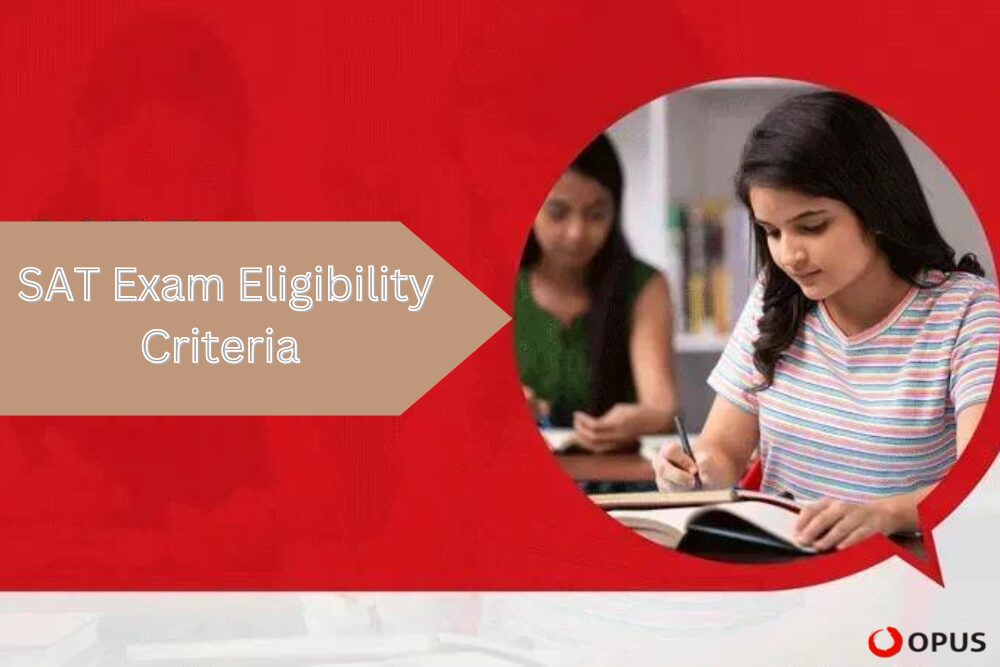Aspiring to take the Guide To SAT Exam in 2024? The initial necessity for your academic trip is criteria that qualify you for mounting your educational direction. The SAT, a worldwide accepted college admissions test, establishes some criteria for its applicants, namely the age limits and educational qualification requirements. By focusing on the intricacies of the SAT exam eligibility requirements that will take effect in the 2024 academic year, we highlight the restrictions concerning the age and educational background of the candidates. Regardless of the person’s position as either a student pursuing a higher education or an experienced professional who wants academic advancement, make yourself acquainted with the SAT exam requirements below to choose the correct options for the SAT Exam fruitfully.
Contents
What is SAT Exam Eligibility?

The organization in charge of administering the SAT must outline the possible SAT Exam Eligibility Criteria. To be eligible for the SAT exam, the aspirants must be of a given age and adequately educated. The SAT refers to any teenager wanting to check their college readiness, especially those interested in enrolling in college in the United States of America, Canada, and the UK, among other places.
Students who want to enroll in international undergraduate programs will need to create an account on the College Board site to pay for their SAT registration. Before registering, candidates must visit the College Board website to check whether they are eligible for the SAT exam.
SAT Exam Age Limit

In general, the conducting agency of SAT has not imposed any age restriction on Indian students yet. Contrariwise, a large number of trainees (around 80%) are somewhere between 17 to 19 ages. Although there’s no maximum SAT exam age limit, the College Board provides specific guidelines regarding age specifications:
- For those aged 13 or above, creating an account and signing up online through the College Board’s official website is free of charge.
- Those 12 years old or younger should register for the SAT by mail.
- The SAT exam age limit for Indian students requires them to be 21 or over and present an official photo ID, such as a driver’s license or passport, to support their candidature.
What is the Required Qualification for the SAT exam?
The SAT exam, conducted by the College Board, is aimed at allowing all students in high school to take the test, irrespective of any special SAT eligibility criteria that may come up. If you are a high school student aiming to enroll in an American or Canadian college, you can participate in the SAT Examination. The aptitude test has gained global recognition and evaluates candidates’ problem-solving abilities and academic aptitude. No educational requirements will be imposed, but the candidates must understand English well since the SAT exam preparation is in English.
SAT Exam Eligibility for ID Proof
The SAT will only verify by asking for government-endorsed documents as ID proof. According to the rule for Indian students, the only allowable document is the passport. It is essential to ensure that the document used as proof of identity is original and not a copy. However, certain documents are deemed unacceptable for SAT exam eligibility, including:
- Digital documents that have been hoodwinked or changed.
- Torn, broken, or tattered IDs may leak personal information easily, leading to data breaches.
- Temporary ID cards
- Birth certificates
- Documents stored on electronic devices where data can be deleted or encrypted make up the electronic evidence.
- Employee ID cards
- Missing child ID cards
- Social Security cards
SAT Exam Eligibility for Passport Size Photo
Among the SAT exam eligibility conditions set by the College Board, candidates are supposed to include a photograph used later on their admissions ticket. The photos are used during the verification and security checking process in the testing centers. The picture submitted should have also been taken based on the particular conditions implemented by the College Board. One should avoid the following things in the passport size photo:
- One should not make the sunglasses a vital feature to hide the candidate’s facial features and impede identification.
- The photo will not have a different person aside from the candidate, as it shift the focus from the candidate’s image.
- Do not opt for low-definition photos as the examination authority will be unable to recognize or verify the candidate’s face in it.
- The candidates should only cover their heads with a hat or something else if it is for some religious reason to make their faces visible.
- Never let even the slightest alteration happen – have the ever-accurate image.
On the contrary, an acceptable photograph, according to the SAT eligibility criteria, should fulfill the following requirements.
- Promote immediate identification of the candidate, ensuring additional reliability and precision.
- Feature only the candidate with nobody else around. Remove other people who are not the candidates in the photo.
- Show the face alone in the depiction of the candidate, letting the eyes, hair, and everything else distinct.
- The photo should be crystal clear without blurriness or becoming all deformed.
- Do your best to avoid low-lying shadow effects that obscure facial features from good view.
- Moreover, it is permitted to use black-and-white pictures only if they comply with the above-stated rules.
Sticking to these rules results in the photograph having its meaning – it’s the one used to identify both students and school security.
What are SAT Eligibility Criteria for Differently Abled Students?
The Tips for SAT exam has no unique selection process for students with disabilities to qualify for the SAT exam. Conversely, the students must contact College Board authorities in time to be allowed accessibility to some special facilities. However, to make such an arrangement, the College Board’s Services should provide prior authorization for the students with disabilities unit. These amenities could be used for SAT General and SAT Subjects Tests if accepted. Some of the facilities for disabled students include:
- Providing Braille and big-size question papers to blind pupils and ensuring that all the pieces of these exams are user-friendly.
- Disbursement of the extra time needed to complete the exam part of the SAT and consideration of the disability in accommodating students.
- The option of using the computer in academic work created an opportunity to present essays without any difficulties in writing and making them legible.
- When choosing extra allowances for rest or help that may be needed during the testing sessions, the board will consider enough breaks during the exam.
FAQs on SAT Eligibility
1. Is the SAT easy for Indian students?
The difficulty of the SAT constraint for Indian students can differ from person to person but generally depends on their strengths, their preparedness, and their acquaintance with the SAT format. For some people, it may not be easy, but others may understand it as something that could be managed with proper digital SAT prep and practice.
2. Can I take the SAT exam after the 12th?
Indeed, according to the SAT exam eligibility, you can take the SAT exam after finishing 12th grade. SAT is a standard test that high school students and seniors can also take.
3. Are 12th marks important for the SAT?
No, SAT score is not necessarily correlated with a candidate’s Grade 12 marks, final year marks, or academic performance. The SAT aims to check a student’s college readiness and reading, writing, and mathematics levels through a well-ordered test.
4. What is the age limit for the SAT?
The SAT does not prescribe a particular age range for candidates to appear in the SAT exam. For more detailed information on the SAT exam age limit, go through the above blog.
5. How many times the SAT exam is conducted in a year?
The SAT is administered seven times per year in India. Typically, the test is taken in March, May, June, August, October, November, and December.
6. SAT vs ACT Exam: Which Test is Right for You?
Whether you take the SAT or ACT depends on different factors that are more or less specified by personal attributes, preferences, and college entry requirements. Though the SAT and ACT evaluate eligibility for entering college, their ways of measuring it differ in structure, contents, and rating. Students will see the variations and think about their capabilities and ambitions, allowing them to select the examination that matches their goals and aspirations.

